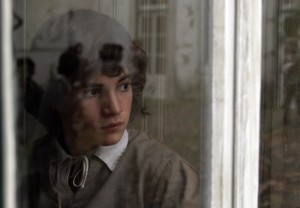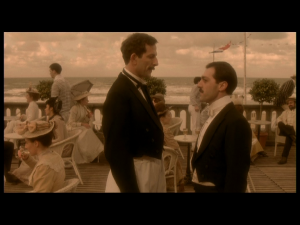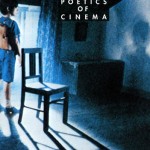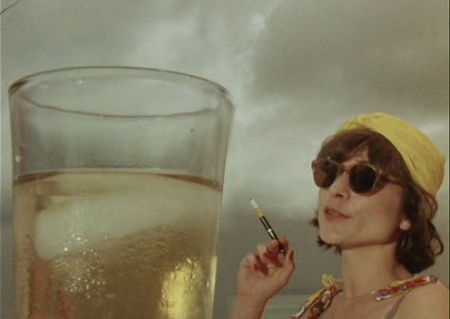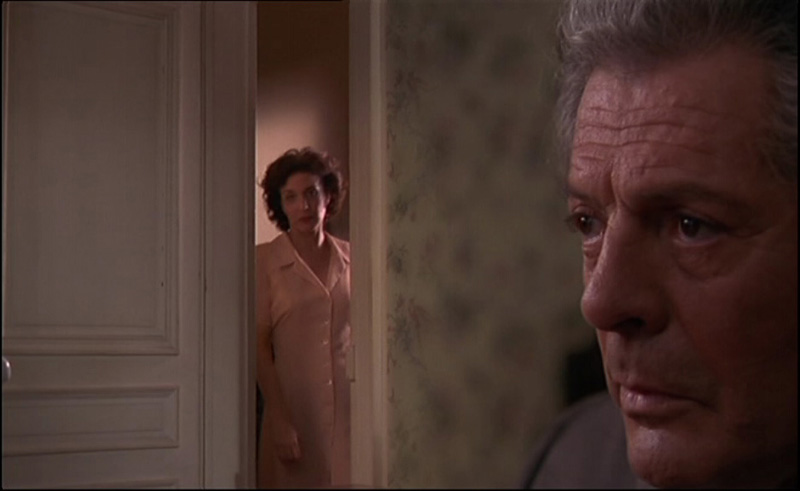Written in late November 2011 for a book on Ruiz published by the Spanish Cinematheque. A shorter version appears with the Blu-Ray of the theatrical version of Mysteries of Lisbon released in 2012 by Music Box Films. — J.R.
It was disconcerting to see a passage from a 1997 article of mine about Raúl Ruiz quoted in several of his mainstream obituaries: “Ruiz is the least neurotic of filmmakers; he doesn’t even seem to care whether what he’s doing is good or not.” Not because this was false when I wrote it but because it related to my earliest encounters with his work and its seeming challenges to film commerce, not to his better known big-budget efforts such as Marcel Proust’s Time Regained and Klimt.
This is why some of these latter films disappointed me, pointing towards what Ruiz himself frankly described to me in a 2002 interview as a “capitulation”. With money often comes anxiety about audiences and investors — and, even worse, not always being able to distinguish clearly between the two – and the cheerful freedom from this anxiety that characterized the extraordinary productivity of first two decades Ruiz spent as a Paris-based exile (roughly 1975 to 1997) seemed to be threatened by his escalation to higher budgets. Even more pointedly and personally, the period when Ruiz and I were friends fell approximately halfway through his most prolific period.
But Mysteries of Lisbon shows retroactively that he may have gained as much from these bigger budgets as he lost, and I’m not speaking about pocket change. What he actually broadened was his film vocabulary, especially his employments of long takes and camera movements. Over the course of well over 100 films, in English, French, Italian, Portuguese and/or Spanish, shot on separate continents over four decades, runs the continuing question of how we position ourselves in relation to a story being told. Whether Ruiz’s working model happens to be Orson Welles or Richard Thorpe, Robert Louis Stevenson or Jorge Luis Borges, the usual strategy is to keep us shifting and guessing.
The challenge of adapting Proust may have clouded this issue, especially when it converted his novel into the equivalent of a theme park. But Ruiz’s “capitulation” also enriched his aesthetics while complicating some of his earlier indifference towards success or failure. Despite his soft-spoken, laid-back manner, he remained a radical both as an intellectual and as a director, and, as with Godard, could be as creative in interviews and written texts as in his films, meanwhile remaining a devout believer in both popular cinema and the avant-garde.
One of his avowed motives for working with serials like Mysteries of Lisbon was their avoidance of “central” conflicts. His ongoing quarrel with what he called the “central conflict theory” behind American-style dramaturgy — which once even led him in his early 20s to quit the University of Iowa’s writers workshop program, following the suggestion of one of the teachers there, Kurt Vonnegut, Jr. — eventually became the basis of the first chapter in his Poetics of Cinema (1995), where he wrote:, “America is the only place in the world where, very early, cinema developed an all-encompassing narrative and dramatic theory known as central conflict theory. Thirty or forty years ago, this theory was used by the mainstream American industry as a guideline. Now it is the law in the most important centers of film industry in the world.”
What are the implications of this law? Skip ahead 13 pages to one of the chapter’s closing arguments:
The criteria according to which most of the characters in today’s movies behave are drawn from one particular culture (that of the USA). In this culture, it is not only indispensable to make decisions but also to act on them, immediately (not so in China or Iraq). The immediate consequences of most decisions in this culture is some kind of conflict (untrue in other cultures). Different ways of thinking deny the direct causal connection between a decision and the conflict which may result from it; they also deny that physical or verbal collision is the only possible form of conflict. Unfortunately, these other societies, which secretly maintain their traditional beliefs in these matters, have outwardly adopted Hollywood’s rhetorical behavior. So another consequence of the globalization of central conflict theory — a political one — is that, paradoxically, “the American way of life” has become a lure, a mask: unreal and exotic, it is the perfect illustration of the fallacy that Whitehead dubbed “misplaced concreteness.” Such synchronicity between the artistic theory and the political system of a dominant nation is rare in history; rarer still is its acceptance by most of the countries in the world. The reasons for this synchronicity have been abundantly discussed: politicians and actors have become interchangeable because they both use the same media, attempting to master the same logic of representation and practicing the same narrative logic -– for which, let’s remember, the golden rule is that events do not need to be real but realistic. (Borges once remarked that Madame Bovary is realistic, but Hitler isn’t at all.) I heard a political commentator praise the Gulf War for being realistic, meaning plausible, while criticizing the war in former Yugoslavia as unrealistic, because irrational.
The metafictional universe of Ruiz is neither real nor realistic — only possible, or let’s say conceivable, because Ruiz thought and filmed it. Whether this makes it good or bad, commercial or uncommercial, is another matter, existing off somewhere in a parallel universe — and fortunately not one that Ruiz had to worry about much, because unlike practitioners of central conflict theory, he usually didn’t have to draw in large crowds in order to keep on working, at least until his “capitulation”.
Did that make him crazy, or us?
Perversely, it was Point de fuite, one of Ruiz’s weakest and emptiest films, that signaled his uniqueness to me more than the much livelier and more inventive La Ville des pirates when I saw both films in Rotterdam in 1984 – my first encounters with Ruiz’s work — because the sheer gratuitousness of the former seemed as potentially fruitful as the radical denials of technique in early Luc Moullet, the cross-references of Godard, the temporal suspensions of Rivette, and the endlessly prolific output of Andy Warhol, all of which could be construed as provocative responses to the usual capitalistic complacencies about craft and consumption. If the limiting factor in most of this work was a whimsical refusal to take even his own premises very seriously — with the striking exception of his neglected and remarkable three-part miniseries for Portuguese television, Manoel dans l’île des merveilles, made shortly afterwards, which carries an uncharacteristic emotional undertow in its relatively unguarded investment in childhood loneliness — Ruiz proudly carried his own hyper-productivity during the period as a badge of honor. And with the stars and increased budgets of Trois vies & une seule mort (1996), Généalogies d’un crime (1997), the Proust film (1999), and Klimt (2006) seemed to come a lessening of that pride and honor.
***
The literary figure behind Mysteries is Camilio Castelo Branco (1825-1890), who authored over 260 books — and, according to James Naremore, “was the first Portuguese writer to live entirely by his pen”. Castelo Branco had an illegitimate birth and became an orphan soon afterwards, granting him from the outset some confusion about his identity that seems echoed in Pedro de Silva, the young hero of Mysteries of Lisbon (1854), one of his earliest books. This three-volume novel seems quite different in structure, tone, and orientation from the same writer’s much slimmer Doomed Love (1862) — the source of Manoel De Oliveira’s eponymous 1979 masterwork, which immediately preceded Oliveira’s long association with the great Paulo Branco, producer of most of the great films of both Ruiz and Oliveira (not to mention key features by Chantal Akerman, Pedro Costa, and Wim Wenders). This makes it all the more pertinent that Castelo Branco’s near-namesake launched this particular literary adaptation, and hired Carlos Saboga to write it, before Ruiz stepped in to direct it. (In fact, before Ruiz died, he and Paulo Branco, who made over 20 films together, discussed adapting another Castelo Branco novel that follows one of the major characters in Mysteries, Father Dinis, as a soldier in Napoleon’s army.)
For all the apparent differences between their source novels, Oliveira’s Amor de Perdicao and the theatrical version of Os Mistérios de Lisboa both run for about 260 minutes (the TV miniseries version of Mistérios is about 100 minutes longer). But the former might be described as a modernist and exhaustive representation of a novel. Ruiz’s masterpiece is a masterful and selective retelling of one, bridging the popular and arcane strands in his oeuvre with fluidity and assurance.
The long takes and camera movements that bigger budgets made more viable became an important part of his style. (In an interview, Ruiz also remarked that the digital Panavision Genesis camera used on Mysteries “completely alters the meaning of direction,” practically eliminating the need for close-ups and representing a return of cinema to more theatrical techniques.) The challenge of his work as a whole while crossing so many boundaries is the way it obliges us to keep repositioning ourselves, and this is precisely, in fact, what his camera movements do.
As I once wrote of Ruiz’s Proust film, “not only camera movements but the gliding displacements of objects and characters [re-create] some of the complex, winding journeys of Proust’s sentences. At a climactic concert at a party, rows of listeners can be seen gliding off in separate directions as if on separate mind journeys, and in a much earlier surreal sequence featuring newsreel war footage in a cafe, the narrator, reading a letter, can be seen rising with his chair like a film director seated on a crane, all the way to the top of the room, where he encounters his own childhood self running a projector…” In a comparable way, it’s Pedro on his deathbed — after over four hours of picaresque adventures and labyrinthine plot twists, either encountering or imagining himself as a child — that bookends Mysteries of Lisbon. Ruiz himself was explicit in his interviews about it being an ending that offers the viewer several choices, none of them exclusive.
Many of the camera movements in Mysteries are mysteries themselves, plotted in and around the mutable aristocratic characters, and sometimes implicitly suggesting the inquisitive and/or critical viewpoints of servants. This in effect deepens as well as sharpens Ruiz’s inquisitive skepticism about narrative itself — as well as which class it can sometimes belong to. And where we choose to position ourselves in relation to all this mystery becomes, of course, part of the experience.
Given how so much of Ruiz’s work remains inaccessible, it would obviously be premature and presumptuous to make any sweeping judgments now about so rich and varied an oeuvre. (Is there anyone alive now who has seen all of it?) But it might already be suggested at this stage that his re-invention of himself as a more mainstream and less independent artist also allowed him to re-invent his playful mistrust of narrative in a less playful and more serious fashion.

